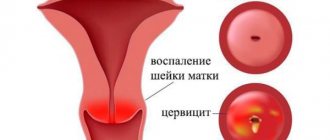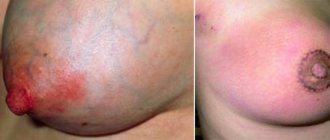The mammary glands take part in lactation and are therefore important for any woman. Discharge from them is either a normal condition or a sign of pathology, judging by the state of health. Yellow discharge from the mammary glands when pressed is considered more of a deviation than normal. Especially if they are painful and bring other changes in the overall picture. In some cases, such symptoms can be observed in men and adolescents; they mean that there is an inflammatory process or some kind of abnormality in the mammary glands.
Discharge from the breast of a healthy woman
The breast is designed to produce milk to feed a newborn baby. The production of nutrient fluid occurs under the influence of hormones that begin to be produced during pregnancy. Hormonal surges during other periods of life lead to the appearance of a small amount of clear secretion.
Breast discharge occurs for the following reasons:
- Colostrum is a special liquid that has nutritional properties, but is not milk. Appears at the end of pregnancy and in the first 3 days after birth. The color is cream or yellowish, the consistency is watery, odorless.
- During lactation, milk begins to be produced 2-3 days after birth. The end of the period depends on the individual characteristics and frequency of feedings. It can last 2-3 years or even longer. Discharge from the mammary glands after lactation is normally observed for several weeks in the amount of a couple of drops when pressing on the nipple.
- After a miscarriage or abortion, colostrum leaks from the breast.
- The release of clear secretion in scanty quantities is possible during puberty, before menstruation and at the time of orgasm.
- When treated with hormonal drugs, tranquilizers, antidepressants, as well as when taking birth control pills, milk or other fluids sometimes appear from the mammary glands. Whether this is normal or not, you need to consult the doctor who prescribed the therapy.
- When there is a blow, compression or other traumatic effect on the chest, non-infectious inflammation occurs; it is accompanied by the flow of bloody or transparent discharge with ichor.
- A few drops of moisture appear after wearing a bra that is smaller than necessary for a long time. As a result of physical activity, medical examination.
Attention! If there is no mammologist in your place of residence, then if you have complaints, you can also show your mammary glands to a gynecologist.
What does the color of discharge mean?
For a mammologist, the determining factors are the consistency and color of the secretion. It is from these characteristics that he can make assumptions about the pathology that caused the discharge:
- Transparent and odorless before menstruation is a normal natural phenomenon.
- White - if this is not caused by pregnancy, indicates a tumor of the pituitary gland, which develops against the background of long-term use of contraceptives.
- Yellow (if the woman is not pregnant), which are accompanied by pain, may be a sign of mastopathy.
- Green ones contain pus; usually in such cases, a woman is diagnosed with mastitis.
- Bloody - indicate destruction of blood vessels and can be a symptom of cancer.
- Dark ones always indicate the formation of cysts and tumors.
What does the green tint mean?
Whether it's green vaginal discharge or from the breasts, it's almost always a sign of inflammation. Liquids are colored by dead bacteria and dead white blood cells as a result of the immune system fighting infection. Watery ones occur in the acute period, when everything is just beginning. Over time, they thicken and become purulent - a yellow-green mucous substance with an unpleasant odor. Normally, the breasts are protected from infection; women are most susceptible to the pathological process during lactation, when the ducts are dilated. But sometimes such an anomaly - ectasia occurs in women after forty, which increases the risk of infection.
Regarding the breast, discharge most often speaks of mastopathy. Due to hormonal imbalances, various formations arise that provoke non-infectious inflammation in the mammary gland. A similar problem can be caused by disruption of the thyroid gland, brain and ovaries.
Manifestation of additional symptoms
The characteristics of the accompanying clinical signs with reddish secretion from the breast largely depend on what specific disease is its cause.
Bloody discharge from the mammary gland that appears when pressed indicates the presence of:
| Pathological condition | Characteristic |
| Intraductal papilloma | It often appears in women over 30 years of age and with the onset of menopause. Additional symptoms include pain, which intensifies when pressing on the chest, and discomfort. |
| Malignant breast tumor | Secretion interspersed with blood is the first sign of cancer, has a thick substance, and is accompanied by other painful and unpleasant signs. |
| Mastopathy | In addition to discharge, increased breast tenderness, swelling, discomfort and tension before menstruation are typical. |
Features of additional symptoms indicating the presence of tumor-like neoplasms depend on their shape and type:
- The discharge has a thick consistency.
- Fluid leaks from only one breast.
- Blood particles (clots) are clearly visible in the exudate.
- Manifestation of asymmetry: the diseased gland is much larger than the healthy one, nodules can be felt.
- Changes in the shape and color of the nipple, the boundaries of the areola and skin are blurred.
- The nipple is pulled inward, the color of the nipple tissue and para-areolar zone increases or decreases.
What diseases cause green discharge from the breast?
There are several reasons for this phenomenon. Each is accompanied by special symptoms that make up the clinical picture of the case.
Mastopathy
One of the most common breast pathologies in women, prevalence is noted in more than 50% of patients. This is the growth of connective tissue in various forms and is a benign process. However, he is able to move into oncology. Therefore, if greenish discharge occurs from the breast, you should immediately contact a mammologist. The full name is fibrocystic mastopathy. But there are 2 types, they are also stages of one disease:
- Diffuse - an increase in connective tissue throughout the breast. Fiber fibers in the form of a nodule or gland in the form of a cyst are located evenly. One type of fabric may predominate in quantity over another. When diagnosed, it is confused with cancer. Moreover, progressive cases actually lead to malignancy.
- Nodular mastopathy sometimes occurs as a result of diffuse mastopathy, when one or several large foci appear in the mammary gland.
Causes of the disease:
- Hormonal disorders, including diabetes;
- Gynecological problems, for example, cyst or multicystic ovary;
- Long-term absence of intimate relationships;
- Unfulfilled motherhood;
- Refusal of lactation;
- Tumors in the hypothalamus region of the brain;
- Serious stress;
- Long-term treatment with hormones;
- Thyroid diseases.
Symptoms:
- Swelling and tenderness in the breasts first appears only before menstruation, and subsequently occurs more and more often.
- Dark green discharge from the nipples, odorless. Sometimes they can be brown or brown. The consistency is liquid-mucous, sticky.
- In the mammary gland with nodular mastopathy, rounded dense nodes ranging in size from a pea to a quail egg are felt.
- The pain intensifies over time and radiates to the shoulder.
Interesting fact! Mastopathy occurs more often in nulliparous women; the more periods and duration of feeding, the lower the likelihood of getting sick.
How to treat mastopathy?
A woman should have a chest x-ray, an ultrasound of the pelvic organs and thyroid gland, and a blood test for the level of prolactin and other hormones. To prescribe a diagnosis, you will need to visit a gynecologist, endocrinologist and mammologist. Sometimes a CT scan of the brain is necessary.
Based on the results of the examination, correction of hormonal balance or anti-inflammatory treatment is prescribed. In rare cases, it is necessary to remove the cyst or node surgically. If cancer is suspected, a mastectomy is performed - the breast is amputated.
Mastitis
Infectious inflammation of the glandular component most often occurs during periods when the ducts are dilated. This is pregnancy and lactation. When milk stagnates, bacteria from outside quickly multiply in it. An inflammatory process with purulent discharge is formed. Yellow-green or light green droplets appear when pressed. They are sticky and may smell unpleasant. The milk takes on a light green tint. Essentially, it is a purulent abscess of the mammary gland.
Reasons for appearance:
- Poor hygiene;
- Rare feedings;
- Incorrect attachment of the child;
- Cracks in the nipples that form due to a previous circumstance.
Symptoms other than discharge:
- Breast swelling;
- Hot and red skin in the area;
- The pain increases when filled with milk;
- Body temperature rises.
Mastitis most often affects only one breast. Therefore, when pus appears, the child should be fed with another gland, and the patient must be expressed and cool compresses applied. The doctor will prescribe antibiotics. Sometimes bacterial culture of the discharge is required to select therapy.
Attention! Pumping and skin contact with the baby helps maintain lactation during the period of treatment and a ban on feeding.
Ectasia of the milk duct
The expansion of these channels outside of lactation is abnormal and occurs due to hormonal disorders. Especially often before menopause. The condition itself does not cause green discharge, but provokes infectious inflammation.
Treatment requires antibacterial and then hormonal therapy.
Papilloma
A benign formation of a viral nature is sometimes found in the breast duct. In this area it is often injured and inflamed. Therefore, there is ichor from the nipples, brown and greenish discharge. The disease has a dangerous high risk of malignancy. Conservative treatment is low in effectiveness; surgical removal is used after histological analysis, which will confirm the risk of oncological degeneration.
Mammary cancer
A disease that can only be treated by timely removal of the breast, along with the muscles underneath it and the lymph nodes.
Clinical picture:
- Seals of uneven shape, welded to the skin;
- Green discharge with ichor from the ducts;
- Nipples are retracted;
- The tumor area resembles cellulite in appearance.
Attention! Similar symptoms occur at the irreversible stage of cancer, when metastases have already spread throughout the body. The initial stages are detected only during preventive examinations, as it does not give any symptoms.
Pathological causes
Hormonal imbalances, inflammation, tumors and pelvic diseases can lead to nipple discharge. Endocrine diseases and abortions often become the main cause of the development of diseases that are accompanied by such a symptom.
To rule out oncology, at the first incomprehensible discharge from the nipples you should go to the doctor. This may be a symptom of pelvic diseases associated with a violation of the internal microflora. These include: candida fungus, dysbiosis, inflammation and tumors in the pelvis.
Breast injuries can also cause inflammation, accompanied by purulent discharge from the nipples.
What should you do if you have green discharge from your nipples?
First of all, assess your condition:
- Feel each breast for lumps and tenderness;
- Palpate the armpits;
- To measure the temperature;
- Press on the nipple and carefully examine the discharge.
This is necessary to explain your complaints to the mammologist in detail. The doctor will perform similar manipulations. Next, instrumental and laboratory diagnostics are carried out:
- Mammography - breast x-ray using special equipment;
- Bacterial culture of infected liquid;
- Blood test for hormone levels;
- Ultrasound of the pelvic organs;
- Consultation with a gynecologist and endocrinologist;
- If necessary, CT scan of the brain.
Attention! The list of diagnostic procedures is individual and depends on the situation of a particular patient. Sometimes only mammography is enough to detect, for example, intraductal papilloma.
Diagnostic measures
Palpation of the mammary glands is one of the methods for diagnosing the disease
At the initial stage of diagnosis, the doctor palpates the breast, specifying the following details:
- presence and location of seals;
- deformations and their nature;
- the amount of secret released when pressed and its properties;
- nature of skin changes;
- condition of the lymph nodes;
- expansion of subcutaneous vessels;
- general condition of the patient’s body.
Based on complaints and the results of a visual examination, a primary diagnosis can be established. To confirm or refute it, the patient may be referred for the following studies:
- Blood test for tumor markers and hormones, general blood test.
- Cytological examination of breast tissue.
- Ultrasound examination of the mammary glands to detect benign tumors.
- Computed tomography to clarify the localization of tumors and the extent of their spread.
- Mammography, which allows to identify tumor processes and other pathological conditions of the mammary glands.
- Magnetic resonance imaging, indicating the cause of discharge from the chest, regardless of its quantity and nature.
Discharge from the chest with purulent contents is a sign of a number of diseases. Therefore, it is very important to conduct a comprehensive diagnosis to clarify the nature of the pathological process in each specific case. Only after this can the doctor begin to develop a treatment course.
Treatment for green pathological discharge from the chest
We have already touched on this topic a little when we talked about each disease. But let's summarize the information:
- If bacteria are found in the liquid, antibiotics are prescribed. During lactation, you may have to switch your baby to formula for a while, and regularly express your breasts so that milk continues to be produced.
- Any hormonal imbalances are corrected by long-term use of appropriate medications.
- Gynecological diseases must be treated simultaneously in the necessary ways.
- Suspicious formations - papillomas, nodes and cysts with a high risk of malignancy are surgically removed. At the same time, they try to restore the proportions and appearance of the breast as much as possible.
- Oncology can be eliminated only by total excision of the entire mammary gland. Subsequently, the patient also undergoes chemotherapy or radiation therapy.
Treatment errors
According to reviews, women with mastopathy often hear from doctors a recommendation to give birth or improve their personal life. Regular sexual relations and motherhood really relieve mastopathy, but such recommendations from the doctor are unethical. Today there are medicinal ways to normalize hormonal balance.
Women during lactation, faced with mastitis, commit irreparable actions. For example, they apply a warm compress to the breast and stop emptying the gland of milk. Which leads to the rapid development of a purulent abscess, which is dangerous not only by cessation of lactation, but also by sepsis.
Physiological reasons
The secretion, which does not look like milk and has an unhealthy odor, requires special attention. Physiological reasons include:
- Pregnancy is when the female body prepares to produce milk.
- Weaning the baby from the breast.
- Abortion (miscarriage) often leads to the release of colostrum from the mammary glands.
- Long-term use of hormonal contraceptives that stimulate lactation. The symptom disappears immediately after discontinuation of the drug.
- Frequent use of antidepressants.
- Constantly wearing synthetic shapewear, which squeezes and irritates the nipples.
- Menstruation.
It is important to remember that in a woman who has given birth, the fluid from the nipples always has a white tint. If the woman has not given birth - only transparent.










